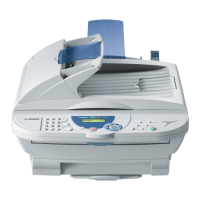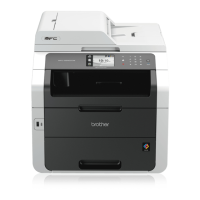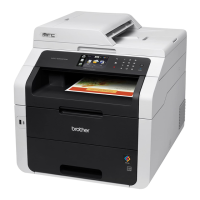Do you have a question about the Brother MFC MFC-9120CN and is the answer not in the manual?
Explains how to navigate and understand the user's guide structure and content.
Defines symbols and conventions used in the manual for clear communication.
Guides on accessing additional detailed guides for software and network functionalities.
Step-by-step instructions for viewing user guides on a Windows PC.
Instructions for viewing user guides on a Macintosh computer.
Provides resources for technical support via website and CD-ROM.
Details the layout and functions of the machine's control panel for user interaction.
Explains the meaning of the Data LED light, indicating machine status.
General guidance on feeding paper and print media into the machine.
Step-by-step instructions for correctly loading paper into the standard tray.
Instructions for loading paper, envelopes, or labels into the manual feed slot.
Illustrates the unprintable margins for faxes, copies, and computer prints.
Lists the types of paper and media suitable for use with the machine for optimal results.
Lists specific paper types that may cause damage or poor performance.
Guidelines for using envelopes, including suitable types and preparation.
Lists specific envelope types that may cause jams or damage.
Information on printing with labels, including types suitable for laser machines.
Lists label types that should not be used to prevent machine damage.
Instructions for loading documents for scanning or copying.
Step-by-step guide for loading documents into the ADF.
Instructions for placing documents on the scanner glass for processing.
Sets the duration the machine remains in a selected mode before reverting to the default.
Configures the machine for the specific type and size of paper loaded.
Adjusts audible alert volumes for rings, beeps, and speaker.
Enables automatic adjustment of the machine's time for Daylight Saving.
Manages power consumption and toner usage for efficiency.
Adjusts the contrast of the LCD display for improved visibility.
Configures an automatic prefix number for outgoing faxes.
Restricts access to machine functions, requiring a password for certain operations.
Prevents unauthorized access to the machine's memory functions.
Allows switching between user modes when Secure Function Lock is active.
Protects machine settings by requiring a password for changes.
Prevents misdialing by restricting access to dial pad, One Touch, or Speed Dial.
General instructions for initiating fax transmission, including mode activation.
Procedure for sending faxes using the Automatic Document Feeder.
Instructions for sending faxes using the scanner glass for single pages or books.
Guidance for faxing Letter size documents to ensure complete transmission.
How to abort an active fax transmission.
Sends the same fax message to multiple recipients simultaneously.
How to configure settings like contrast and resolution before sending faxes.
Automatically adds a cover page with sender details and comments to faxes.
Adjusts the lightness or darkness of the fax image for optimal clarity.
Modifies the fax resolution to improve the quality of outgoing faxes.
Allows simultaneous operations like scanning while sending or receiving faxes.
Enables immediate fax sending without waiting for memory transmission.
Allows scheduling faxes to be sent later within a 24-hour period.
Allows users to monitor and cancel pending fax jobs.
Guides users through manually initiating and sending a fax transmission.
Provides solutions for handling "Out of Memory" errors during fax operations.
Explains how to choose a receive mode based on line setup and connected devices.
Details the operation of Fax Only, Fax/Tel, Manual, and External TAD receive modes.
Adjusts ring delay and Fax Detect features for optimal fax reception.
Adjusts the darkness or lightness of printed output for received faxes.
Features for printing reduced faxes and setting receive stamps.
Stores incoming faxes in memory when paper is unavailable.
How to print faxes stored in the machine's memory.
Discusses compatibility with telephone services like Voice Mail and Distinctive Ringing.
Explains Telstra's FaxStream® Duet® service for distinguishing call types.
Describes Telecom's FaxAbility service for managing multiple numbers on a line.
Details using Distinctive Ringing for dedicated fax numbers in specific regions.
Describes the Caller ID feature and how it displays incoming call information.
Guides on connecting an external Telephone Answering Device to the machine.
Diagrams showing how to connect external TADs and telephones.
Instructions for recording an OGM for an external TAD, including activation codes.
Discusses connecting the machine to PABX systems and potential issues.
Covers operation and connection of external and extension telephones.
Tips for using cordless handsets with the machine.
Information on enabling and using remote activation and deactivation codes.
Explains different methods for dialing numbers, including manual, One Touch, and Speed Dial.
General guidance on storing One Touch, Speed Dial, and Group numbers.
Describes the automatic redial feature for busy lines.
Detailed steps for saving numbers to One Touch keys.
Instructions for storing numbers in Speed Dial locations.
Allows combining multiple dial entries for easier dialing.
How to switch dialing modes for compatibility with phone services.
Automatically forwards received faxes to another destination.
Stores incoming faxes in memory for later access.
Stores received faxes in memory and sends them to a PC automatically.
Modifies settings for remote fax features like forwarding or storage.
Deactivates remote fax features.
Allows retrieving stored fax messages remotely using a phone.
Establishes a unique code for accessing remote retrieval features.
Explains how to use the remote access code to operate the machine remotely.
Step-by-step instructions to retrieve stored faxes remotely.
Updates the number to which received faxes are forwarded.
Lists commands used for remote operation of fax features.
Allows the machine to call another fax machine to retrieve faxes.
Restricts polling access to authorized users with a secure code.
Schedules the polling process to start at a specific later time.
Requests documents from multiple fax machines in one operation.
Holds a document for another machine to retrieve.
Configures the machine to hold documents for retrieval.
Secures polled transmit documents with a code for authorized access.
Guides on setting up and printing various fax activity reports.
Provides proof of fax transmission success and details.
Lists incoming and outgoing fax activity details.
An overview of available reports like Help List and User Settings.
Instructions on printing various reports directly from the machine.
Basic instructions for making copies, including entering copy mode.
Procedure for creating one copy of a document.
Instructions for producing multiple copies of a document.
How to cancel a copy job.
Allows temporary adjustment of copy settings like Enlarge/Reduce.
Guides on adjusting the size of copies using predefined ratios or custom percentages.
Explains how to use the Options key for quick copy setting adjustments.
Options to adjust copy quality settings like Auto, Photo, or Text.
How to sort multiple copies made from the ADF.
Guides on adjusting contrast, brightness, and colour saturation for copies.
Feature to print multiple pages onto a single sheet to save paper.
Instructions for handling "Out of Memory" errors during copying.
Enables direct photo printing from compatible digital cameras via PictBridge.
Guides on configuring the digital camera for PictBridge printing.
Lists necessary items and conditions for connecting a camera for printing.
Step-by-step instructions for printing photos from a connected camera.
Details printing photos when security lock is active, including access restrictions.
Information on printing images using the Digital Print Order Format standard.
How to connect cameras not supporting PictBridge as a standard storage device.
Explains common PictBridge errors like "Out of Memory" and "Unusable Device".
Lists the file formats compatible with direct printing from USB drives.
Instructions on how to generate specific file formats for direct printing.
Step-by-step guide for printing files from a USB flash drive.
Procedure for printing from USB drives when security lock is active.
Explains errors related to USB printing, such as "Out of Memory" or "Unusable Device".
Guidance on navigating and utilizing the HTML user guides.
Instructions for accessing guides on Windows systems.
Instructions for accessing guides on Macintosh systems.
Crucial safety information, legal disclaimers, and compliance details for product usage.
Details on optional hardware components like memory expansion.
Comprehensive guide for resolving issues and performing regular upkeep procedures.
Explains how to navigate and use the machine's menu system for configuration.
Technical data and performance details of the machine.
Definitions of technical terms and features relevant to Brother manuals.
| Print Technology | Laser |
|---|---|
| Connectivity | USB 2.0, Ethernet |
| Duplex Printing | Manual |
| ADF Capacity | 35 sheets |
| Fax Modem Speed | 33.6 Kbps |
| Functions | Print, Copy, Scan, Fax |
| Maximum Printing Speed (Black) | 17 ppm |
| Maximum Printing Speed (Color) | 17 ppm |
| Monthly Duty Cycle | Up to 30, 000 pages |
| Scanning Resolution | Up to 19200 x 19200 dpi (interpolated) |
| Optical Scan Resolution | 1200 x 2400 dpi |
| Memory | 64 MB |
| Paper Handling | 250-sheet input tray |
| Scanner Type | Flatbed |
| Copy Speed | Up to 17 cpm |
| Paper Capacity | 250 sheets |
| Print Speed | Up to 17 ppm (Black/Color) |











